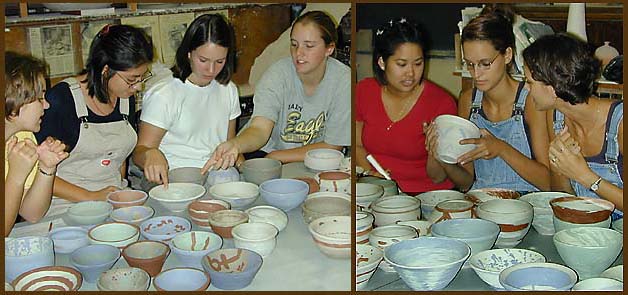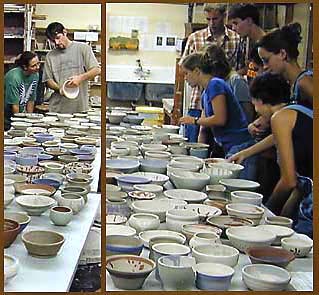
The Assignment PURPOSES are to gain skill on a potter's wheel, to gain experience decoration, and to learn about the merits of various bowl ideas and features. 
First term ceramics students discuss their greenware thrown bowls. Each student brings 12 decorated and trimmed bowls to the discussion. Photo: September 27, 1999 © Marvin Bartel, instructor
PREPARATION: Carefully observe the instructor's demonstration. Mimic hand positions while watching to help your memory. Select soft enough clay to be easy to wedge and center, but not too sticky. Wedge or knead 5 pound balls of clay. Wedge until there are no harder lumps or softer areas in the clay (throwing is impossible if clay has lumps). A good learning method is to mix two colors of clay until they are one uniform color. About 50 actions on the clay while wedging generally does a good job. Divide the 5 pounds into several pieces from which to make bowls. You may make the bowls any size you wish. Wrap prepared balls in plastic until used. If stored in your shelf overnight, rewedge briefly before using. HINTS: Follow procedures suggested in the throwing demonstration. Refer to the instruction sheet or poster for hand positions. Ask for advice if things aren't going well. Have the instructor or assistant watch you do the part which gives you difficulty so that he/she can suggest possible corrections. Almost everyone benefits from some individual tutoring at this point. A Learning to Throw program has been prepared and posted on the Internet to help you. Please take some time to look at it now and come back to it when you can. It includes detailed illustrated instructions for each step in using the wheel. In the textbook, see Chapter 12 starting on page 231 the 4th edition of Hands in Clay. Wedging is very important when using the wheel. See page 188 for review. photo © bartelart.com
1. A bowl is a container. Consider the inside form. Consider its contour. Does it form a smooth continuous contour sweeping down, across the bottom, and up the other side? Does the outside form match the inside form (after trimming)? 2. A bowl is used. Is the rim sturdy? Are the edges of the rim nicely rounded off? Are the edges sharp and prone to chipping? 3. Is any part of the bowl significantly thicker than the rest. Bowls generally have a uniform thickness except for a slight thickening at the top rim. They may have foot rim which is trimmed to relate closely to other aspects of the bowl. Often a trimmed foot rim is about as thick or slightly thicker than the top rim of the bowl. 4. Do the contour lines flow gracefully or do they hesitate? Does it have strong angles and rims, or does the bowl feel undecisive? Compare various ideas and study them to see how you want to refine the shape and the rim. 5. What about the proportions. What are the height and width size relationships? Do you want it deep or wide? Why? What do the proportions say about the bowl's function? Does it appear generous or restrictive? 6. Does the size of the foot make the bowl look larger or smaller by comparison? Does the foot appear to be a supporting ring or does it make the piece appear to emerge from the table? The maker of bowl, you, decides on the visual effects and feelings you want from your vessels. 7. Do your surface decorations make the form more important or do they contradict the form? What is symbolized by the decoration? Does the decoration add to the feeling of motion, stability, formality, casualness, joy, sadness, etc.?  Peers "read" and say what they see when looking at each other's bowls. They start by describing what they see that makes a particular bowl more desirable to them. All rights reserved. © Marvin Bartel 2001 Any reproduction or publication is prohibited unless permission in secured. Contact the author to secure permission. back to syllabus
|


